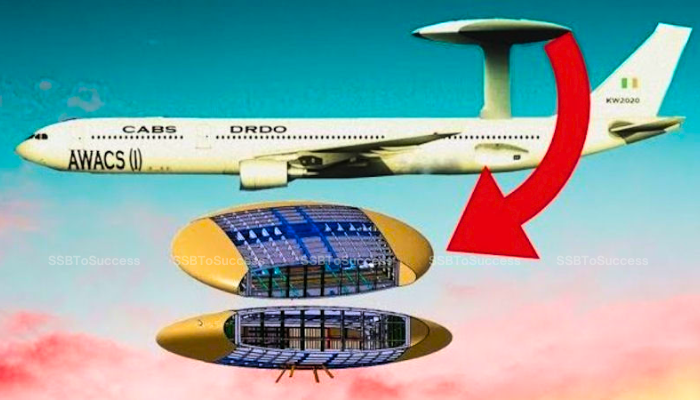What Does AWACS Stand For?
The Airborne Warning and Control System (AWACS) is a highly mobile surveillance system designed to provide air defence. The primary mission of the AWACS fleet is air surveillance, warning and control system support, and air defence.
One AWACS aircraft flying at 9,000 m can cover an area of 3,12,000 km. Three such aircraft in overlapping orbits can cover the whole of Central Europe.
The need for AWACS is being developed primarily to fulfil two vital military requirements, those of strategic air defence and tactical command and control. It can also be useful in nonmilitary peacetime uses. There has been no great technological advance in radar since the 1950s when the basic threat was high-altitude subsonic bombers.

How Does AWACS Work:
AWACS is built on a Boeing 707 airframe. A surveillance radar system is located in the rotodome above the airframe. An Electronic Support Measures system has antennas on the cheeks of the airframe, under the nose, and in the tail. The E-3 has 13 Ultra High Frequency radios, 4 Very High Frequency radios, and 3 High Frequency radios.
The human-computer interface is built on the Windows operating system and licenses the Raytheon Solipsys Tactical Display Framework.
Some Important Features:
The AWACS is to provide tactical air forces with quick-reaction surveillance, command and control, for gaining and maintaining air superiority in a tactical theater. The AWACS aircraft will provide an extension of the ground surveillance and control system during sustained air operations such as counter-air, interdiction, close air support, reconnaissance, and airlift. The system also provides an all-altitude warning and detection capability which improves the Alliance’s maritime surface picture, essential for surveillance operations.
The changing nature of the international security environment in recent years has also led to the deployment of the force on more complex and tactical missions, including air-to-air and air-to-ground control, airspace management, air policing, combat search and rescue, force marshalling and threat warning.
This upgradation will provide the following features also:
- Software to automatically refresh the onboard database.
- An updated mission system health monitoring tool.
- Improved interfaces and controls of the onboard passive Electronic Support Measure system.
- Improved mission planning and post-mission processing capabilities
AWACS during the Mission:
- Provide early warning, air surveillance, air battle management, and beyond line-of-sight capabilities.
- Provide command and control of offensive and defensive counterair and counter-sea operations, and strike missions including dynamic targeting, close-air support, suppression of enemy air defences, and strategic attacks.
- Manage air refuelling operations, combat search and rescue missions, and special operations missions.
How Many AWACS Does India Have?
The IAF currently operates only three Israeli Phalcon AWACS mounted on Russian IL-76 transport aircraft, which provide 360-degree radar coverage and a range of 400 km. Pakistan possesses 11 Swedish Saab-2000 Erieye AEW&C and Chinese Karakoram Eagle ZDK-03 AWACS aircraft.


